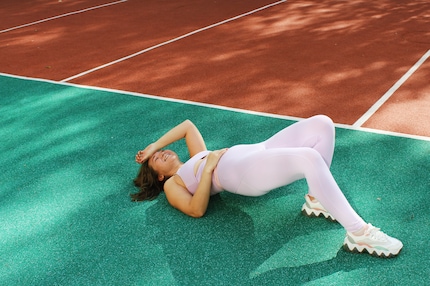
Background information
A textiles expert’s tips to make your outdoor clothing last longer
by Siri Schubert

People like to turn up their noses at polyester clothing. However, the material definitely has a right to exist, as lecturer Angela Wagner explains.
Polyester is one of the most widely used fibres in the clothing industry - and is dismissed by many as cheap plastic. However, the material has a lot to offer from a textile technology perspective. Graduate textile engineer Angela Wagner lectures at the STF Swiss Textile College, where she heads up the Junior Product Manager programme. She explains what makes polyester unique, why it stinks faster than natural fibres and what sustainable innovations are currently being researched.
Angela, polyester has a bad reputation. As a textile expert, do you give it a wide berth?
On the contrary. As a passionate textile engineer, I can get excited about all kinds of fibres.
What exactly excites you about polyester ? Polyester is a quick-change artist. The material is particularly outstanding in the functional area - and can do many things that natural fibres cannot.
So natural fibres are not fundamentally better?
No. The choice of fibre always depends on what the garment ultimately needs to be able to do.
What makes polyester a popular choice for functional clothing?
Polyester has a high tensile strength and is resistant to deformation, light and weather. In other words, it is very robust. The fibre also absorbs hardly any moisture. This is particularly relevant in the sports and outdoor sector.
Can you do that?
When you sweat in a cotton T-shirt, the fibre soaks up moisture and stays wet for a long time. As a result, our body cools down. An effect that we want to prevent. Polyester fibres, on the other hand, absorb virtually no sweat, instead wicking it to the surface where it can evaporate.

So why does sweating in polyester clothing sometimes feel so uncomfortable?
Because the wearing comfort also depends heavily on the finish. In other words, what type of yarn the fibres are spun into. And even more important: how the yarn is ultimately processed, for example as a knitted or woven fabric. Knitted fabric is more permeable to air than tightly woven material.
Polyester smells quicker than natural fibres. Why is that?The fact that polyester hardly absorbs any moisture is a disadvantage in this respect. When we sweat heavily, the sweat remains on the surface. Bacteria, which naturally colonise our skin, love to multiply in this warm and humid climate. By decomposing the sweat, they create an unpleasant odour for us.It is commonly said that synthetic fibres are not breathable. A myth?Breathability describes the exchange between body, material and environment - i.e. whether air can be transported in and moisture can be transported out. Polyester fibres generally offer these properties. However, as mentioned, breathability also depends on the construction of the material.So it's not enough to simply pay attention to the type of fibres?Exactly, several components contribute to the breathability of clothing. What many people also forget: If you wear a jumper or jacket over a breathable shirt that doesn't support this function, it will impair the effect. This is why manufacturers often offer entire clothing systems for functional fashion. This ensures that the desired functionality is maintained in every layer.[[image:75656388 "The «Pleats Please» line by Issey Miyake consists mainly of pleated polyester fabrics." "Instagram @pleatspleaseisseymiyake"]]Polyester is therefore indispensable in the functional sector. What advantages does the material offer in everyday clothing?When polyester was introduced in the 1950s, the main selling point was that it didn't crease. This is still a major advantage, especially when travelling. Polyester is also very easy to care for. What is interesting in terms of design is that, unlike most natural fibres, the material is thermoplastic and therefore malleable. This makes it possible to produce pleated fabrics, for example. Polyester is generally very easy to modify.This means in this contextThat the outer shape and therefore the look and feel of the fibre can be easily changed. Polyester can sometimes resemble silk, sometimes cotton. From fine dresses to coarse outdoor jackets, a wide range of garments can be realised. The inner life of the fibre can also be adapted. So-called hollow fibres, for example, offer high air entrapment and are therefore particularly light and warm. By adding flame-retardant substances, polyester can even be used to make firefighting equipment. This is currently not possible with natural fibres.[[image:75656407 "Polyester fulfils an important purpose in protective clothing." "Pixabay via Pexels"]]Why is polyester so often equated with poor quality anyway?I think this is due to historical reasons. In the early days, polyester clothing had a strong synthetic character and was mainly used for suits and shirts. It neither felt good nor looked good. In the meantime, however, processing has come a long way.What kind of clothing do you advise people not to use polyester for?This is something very individual. I wear polyester and polyester blends mainly for sports. For knitted jumpers, I clearly prefer wool or other animal hair such as cashmere or alpaca. But if a polyester blouse feels great and has a particularly beautiful colour or high-quality finish, I wouldn't rule it out in principle. After all, there are premium labels that make wonderful clothes from it. And although synthetic fibres are cheaper on average than cotton or wool, there are also expensive polyester fabrics. Can you explain how polyester is made?Simplified, production begins with the conversion of crude oil into an acid. When alcohol is added, a chemical reaction known as esterification occurs - hence the name of the fibre. This produces the substance PET. Under pressure and heat, these PET molecules are combined into long chains, resulting in a soluble granulate, a kind of tough dough. This mass is then pressed through spinnerets, similar to a shower head. The resulting fibre strands are fixed with cold air and produce the polyester filaments.How sustainable is polyester compared to other fibres?This is not so easy to answer, as there are many factors to consider. For example, CO2 emissions, water consumption, durability and recycling of the material. Polyester is usually made from crude oil and is therefore not biodegradable. In this aspect alone, sustainability is not a given. However, I do see potential in terms of recycling. Recycled polyester is already being used in many places and the textile industry is currently investing a lot of research into different recycling strategies.You say "as a rule". So isn't polyester always made from crude oil?Bio-based polyesters are slowly coming onto the market. They are increasingly being made from corn starch and are therefore biodegradable. However, this raises the question of whether it is ethically justifiable for food to be processed into textiles. What are the challenges of recycling polyester?Polyester is easy to recycle as long as it is a pure textile. It becomes more complicated with blends. The textile industry is currently working on being able to digitally identify the individual fibres in order to separate them effectively. I think this is a promising approach. It is particularly relevant as textile blends are widely used in the clothing industry.[[image:75656391 "Recycled polyester fibres from PET bottles sometimes do not have the desired colour and strength." "Mali Maeder via Pexels"]]Are there quality compromises with recycled polyester?In part, yes. That's why you often see fabrics that contain a blend of new and recycled fibres. However, work is underway to bring the quality of recycled polyester from PET bottles and textiles up to the level of newly developed polyester. In what way is recycled polyester inferior?The fibres are not inferior per se. However, they are subject to greater fluctuations. They may not have the desired strength or the colour may not be pure white due to the different PET bottles - and therefore not every colour can be produced from them.Polyester is also often criticised because synthetic fibres are one of the main sources of microplastics.Microplastics is a highly topical and complex topic in which the textile industry, along with other industries, plays a significant role. Various studies have shown that a low spin cycle and a washing temperature of around 30 degrees can counteract the release of microplastics. A gentle wash cycle should not be used for synthetic fabrics - the higher water volume rinses out more fibres. Washing machine manufacturers also often offer corresponding filters.Isn't microplastic a reason to avoid polyester altogether?Of course, the ideal scenario would be for us to have a sustainable replacement one day. But until this scenario materialises, I think the best option is to keep the raw materials in the cycle. Titelfoto: Issey Miyake via Launchmetrics/Spotlight
Has endless love for shoulder pads, Stratocasters and sashimi, but a limited tolerance for bad impressions of her Eastern Swiss dialect.
Interesting facts about products, behind-the-scenes looks at manufacturers and deep-dives on interesting people.
Show all
Background information
by Siri Schubert

Background information
by Martin Rupf

Background information
by Siri Schubert